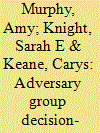| Srl | Item |
| 1 |
ID:
156901


|
|
|
|
|
| Summary/Abstract |
Anticipating whether an adversary group will continue to use their usual (“conventional”), expected attack methods is important for military and counterterrorism practitioners tasked with protecting the security of others. Conventional attack methods are by their nature easier to plan and prepare for whilst “innovative” methods may take those responsible for security and counterterrorism by surprise and, as such, may have more impact and more serious consequences. The present study aimed to develop understanding of how, when, and why adversary groups might decide to use conventional attack methods or opt to do something innovative instead. A literature review was conducted and findings were applied to develop a thorough understanding of the decision-making process that underlies an adversary group's choice of attack method. Identified are three stages preceding the execution of an attack: a) “strategic direction”; b) “incubation”; and c) “planning and preparation,” plus “overarching” and “contextual” factors that can influence the process at each stage. It is suggested that it is these factors and how they influence decision-making that result in innovative methods being used to execute an attack, or convention prevailing. Findings can aid practitioners and policy-makers in counterterrorism, security, and law enforcement, to support their understanding, evaluation, and countering of current and future threats.
|
|
|
|
|
|
|
|
|
|
|
|
|
|
|
|
| 2 |
ID:
151707


|
|
|
|
|
| Summary/Abstract |
The paper explores terrorist choice by applying two well-known theoretical frameworks: stochastic dominance and prospect theory (PT). We analyse each pair of attack methods that can be formed from the RAND-MIPT database and the Global Terrorism Database. Instances of stochastic dominance are identified. PT orderings are computed. Attention is accorded to the identification of ‘trigger points’ and the circumstances that may lead to an increased likelihood that a terrorist will select an attack method associated with a higher expected number of fatalities, i.e. a potentially more damaging attack method.
|
|
|
|
|
|
|
|
|
|
|
|
|
|
|
|